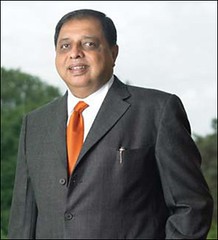
PREV ARTICLE
NEXT ARTICLE
FULL ISSUE
PREV FULL ISSUE
INDIAN BANKNOTE COLLECTOR TO OPEN MUSEUM, PUBLISH BOOKS
An Indian bank note collector is planning to open a museum and publish two books on the subject.
-Editor
But there's something about Razack that few people know - he is India's biggest collector of banknotes, who claims to possess one, or more, of every variety of paper currency printed in India since 1770s, when private banks in India first began issuing banknotes. And now Razack is ready to throw open his exhaustive collection to interested viewers. Later this year, he will open a museum housing his collection in a 4,000 sq ft space in Prestige Shantiniketan, a large mixed-use development in Bangalore's Whitfield area. When it opens it will be the country's first museum of banknotes. (The RBI Monetary Museum and Dinesh Modi Numismatics Museum at the University of Mumbai's [ Images ] Kalina complex have banknotes, but they have coins as well.) Razack, 55, says he has been collecting banknotes for the last 40-45 years, since he was a child. "My family members were traders and we had a treasury in the house where they would keep money. Few people in those days went to banks for fear they would go bust. They'd give me bundles of banknotes and tell me to put it inside the treasury. Once I found a note with the inscriptions, 'Reserve Bank of India' [ Get Quote ] and 'Government of Pakistan', and 'payment refused' overwritten on it. I went and gave it to my elders who started complaining that they had been cheated." Young Razack kept the note, not knowing that these were a historical oddity -some of the notes issued by RBI during the 10 months immediately after August 15, 1947 when it was also the currency-issuing agency for Pakistan. Today, these notes sell for anywhere between Rs 10,000 and Rs 100,000, depending on denomination and condition, says Kishore Jhunjhunwala, a prominent collector of banknotes and author of Standard Reference Guide to Indian Paper Money. Over the years, Razack continued to collect banknotes - at first smuggling out one or two unusual specimens from the wads his uncles gave him. As his collection grew, he began visiting cut-note dealers and later, stamp dealers and auctions in India and across the globe. Since 1998, he has also been buying online, via eBay. It wasn't easy, he says. For one, there was very little information on the kinds of banknotes, the watermarks, printing and other finer details. And two, unlike coins, old paper money was hard to come by. "Culturally, Indians don't get paper money. Many people have old coins, but seldom banknotes. It was only when someone put them away and forgot all about it for so long that they were demonetised, that they got preserved. Besides the museum, Razack is also ready with two books, which too will come out later this year, he says, "The first, a coffee-tabler called For the Love of Money, will highlight unique banknotes such as the fractions - two-and-a-half rupees, and other, the 'stars' that did not make it." The other will be a pictorial catalogue of the history of Indian banknotes giving all details of watermarks, printers, signatures, issuing banks, circulation dates - a kind of reference guide to collectors.
To read the complete article, see:
Meet India's biggest collector of banknotes
(business.rediff.com/special/2010/sep/23/spec-meet-indias The Numismatic Bibliomania Society is a non-profit organization promoting numismatic literature. See our web site at coinbooks.org. To submit items for publication in The E-Sylum, write to the Editor at this address: whomren@gmail.com To subscribe go to: https://my.binhost.com/lists/listinfo/esylum All Rights Reserved. NBS Home Page Contact the NBS webmaster 
|
